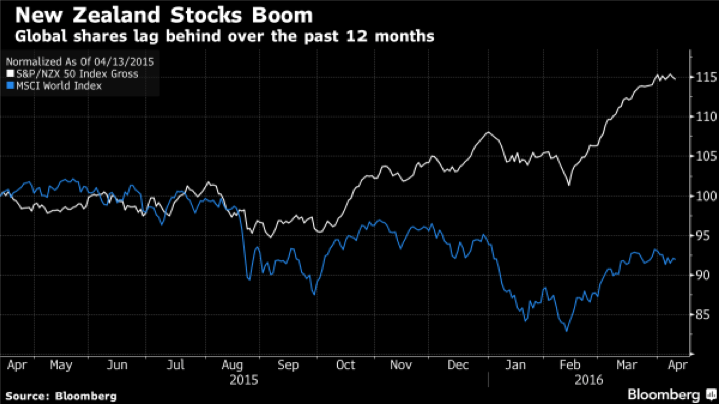
Over the Ditch or Over the Cliff?
It’s not hard to find people who love New Zealand – the scenery, the adventure activities and the people are all simply amazing. On one measure however it appears that New Zealand may be loved to death.
According to Bloomberg; “The S&P/NZX 50 Index is the world’s best-performing developed stock gauge this year, climbing more than 7 percent to a record after overseas buying of equities jumped 21 percent in 2015. That’s driven stock valuations in the South-Pacific nation close to a record high, leaving them more expensive than anywhere else in the region.”
According to some observers, significant overseas buying of large cap stocks is responsible not only for their “unusually” elevated levels – the S&P/NZX 50 is trading at 19.4 times estimated earnings, but also the fact that foreign owners can lay claim to about a third of the market, according to estimates from JB Were.
Some fund managers are heavily overweight New Zealand with the UK manager LionTrust’s Asian Equity Income Fund allocating 4.5 per cent to the country versus its 0.1 per cent weight in the MSCI All Country World Index.
The reason for the foreign fascination is high dividends. According to Michael Kerley from Henderson Global, “It’s difficult to ignore companies with such high yields…It’s got to be a market we keep looking at. The yields are so high.”
If that sounds simultaneously irrational and familiar recall our warning in The Australian when Telstra was trading over $6.50 and again when the NAB was trading at close to $40. Investors who chase yields from companies that don’t retain meaningful amounts of capital and therefore are unable to grow earnings to justify the higher share prices, will ultimately lose more capital than the additional yield they gained.
It seems silly people live in all different countries. The fundies from London, mentioned by Bloomberg, chasing New Zealand’s highest yielding shares might do well to read our explanation below of the arithmetic and risks associated with chasing yield rather than growing income, as well as the Australian experience.
In the meantime, don’t fall too deeply in love with New Zealand.
…
High yielding shares might just be a sure fire way to do your dough.
This time last year, investors saw their million-dollar term deposit earning less than the poverty line, and hurt by their own private income recession, chased high dividend yielding blue chip stocks.
The chase pushed the shares of large but mediocre companies like the National Australia Bank to almost $40 and Telstra to $6.60 but as the more recent declines accelerated they revealed the hunt for yield was merely another one of the stock market’s conga-line of fads.
Where did baby boomers go wrong? And why, after so many years, has the stock market not risen above its pre-GFC highs? The answer to these two questions – as well as whether investing in an Australian index fund is a good idea – is the same.
For the last few years, investors have made off handsomely by simply buying large cap stocks with high yields like banks and Telstra. Low yielding term deposits have plunged retirees into what can only be described as an Income Recession and their cries have been heard by company boards, who have acquiesced to their demands for more income from shares by raising their company payout ratios.
This will prove to be the great undoing for many retirees’ investment portfolios because the corollary of high payout ratios is low growth, and what retirees will need in a few years is not a high yield but growing income.
The mechanics
The maths is pretty simple. If a company with ten dollars of equity earns a 20 per cent return on equity every year and pays out one hundred percent of those earnings as dividends, its equity doesn’t grow (assuming no more debt or fresh capital is raised). If the equity doesn’t grow and the return on equity remains constant, the earnings don’t grow either. If the earnings don’t grow, the dividends cannot.
If we make the assumption that the stock market never changes how popular the shares are and they always trade on a price earnings ratio of, say, ten times next year’s earnings, then we can buy the shares in year one for $20.00, receive two dollars of dividends each year and sell the shares at some future date for $20.00. Our internal rate of return will be 10% which is precisely equal to the dividend yield at the time of purchase.
Sadly, that dividend yield is the maximum return investors can expect. Unless they successfully speculate that the P/E ratio might rise (we, as a reminder, are investors not speculators), their best return is the dividend yield.
Investors who appear to have been smart buying stocks with yields a little higher than term deposits will soon find their income fixed by the high payout ratio and the purchasing power of their income eroded by inflation.
The impact of this cannot be overstated.
If the above company paid none of the earnings as a dividend, all of the earnings would be retained and the equity, the earnings and the share price would all rise by 20 per cent per annum – equivalent to the return on equity of the company – yielding a return that was double that of the first investor.
Let’s look at some real and recent examples. In 2005 you could have invested $100,000 in the shares of Telstra – a company that was paying more than 100 per cent of its earnings as a dividend – at $4.69, paying a dividend of 28 cents for a yield of just less than six per cent or income of $5,900.
As an alternative, you could have also invested in the shares of another telco called M2 Telecommunications – a company that was retaining a meaningful proportion of its profits and compounding them at an attractive rate of return on incremental equity. M2 was trading at a bout 30 cents and was paying a dividend of about 1.25 cents, which corresponded to a yield of just 3.90 per cent.
Any dividend hungry investor would have gone for the higher-yielding Telstra shares. Telstra pays a sizeable proportion of its earnings out as a dividend. This high payout ratio is what has made its shares so attractive to income investors. The corollary of a high payout ratio however is that the company retains relatively little for growth. To illustrate, Telstra recently reported its half yearly results for 2016. For the six months ending December 31, 2015, the company reported EBITDA of $5.4 billion, Net profit after tax of $2.1 billion and earnings per share 17.2 cents. Go back ten years and for the six months to December 31, 2005 Telstra reported EBITDA of $5.3 billion, Net profit after tax $2.1 billion and earnings per share 17.3 cents. In other words, after a decade of operations, the company has not grown earnings.
Returning to our $100,000 investment in Telstra in 2005 and ten years later – in 2015 – the $100,000 invested in Telstra has grown to about $117,000 and the $6000 of income in 2005 has grown to about $6400 and failing to maintain your purchasing power.
This is not the best outcome for investors. Even income investors need growth. Why? Because without growth in earnings, there can be little growth in dividends and without growth in dividend, a retiree’s income will be eroded by inflation.
Contrasting the Telstra example with M2 and despite M2 displaying a lower yield in 2005, the capital return and the income growth has been far more attractive. Thanks to the company generating a similar average return on equity as Telstra, but unlike Telstra, retaining a compounding a portion of the earnings, a $100,000 investment had grown to more than $3m by the end of 2015 and more importantly for income hungry investors that $3910 of annual income in 2005 had grown to over $99,000 – yes that’s correct – by 2015.
Perhaps unwittingly, investors in their hunger for income, chased stocks that were neither blue chip nor high yielding. And that includes Telstra and the NAB. Not only have baby boomers lost capital sufficient to wipe out years of the additional yield they’d hoped to gain, but they also missed out on capital and income gains from the businesses that were able to grow both their intrinsic value and income.
What the above examples demonstrate is that yield hungry investors have been chasing the wrong yields. Rather than pursuing the big, stable so-called ‘blue chips’ they should be investing in companies that can grow. Find companies that can retain profits profitability and both capital and income will grow. But woe to you who buys a mature or expensive blue chip company with now growth – both your capital and the purchasing power of your income will decline.
And finally, what does any of this have to do with index investing? The Australian indices are made up of the big lumbering blue chips – those mature businesses paying the bulk of their earnings out as a dividend. If their equity and profits aren’t growing, neither can their shares sustainably, nor the index which is based upon them.
Want low returns? Go for the high dividend yield.
Roger Montgomery is the founder and Chief Investment Officer of Montgomery Investment Management. To invest with Montgomery domestically and globally, find out more.

I absolutely agree that for some traditional blue chips, markets are mature and chasing yield is a losing business. For years I’ve pointed out to friends the saturation of markets, with the inertia in NAB’s share price over the past few decades being my favourite example (I believe that the unravelling of peak capitalism has commenced). As you point out, at this time there are small blue chip companies and potential areas of substantive growth, such as in health. Not having the expertise to identify these opportunities, I achieve a good return by opportunistic share trading a few big blue chips patiently and without succumbing to greed. My significant risk is really bad news overnight. However, most people are not equipped technically nor psychologically to trade successfully: hence the service you provide.